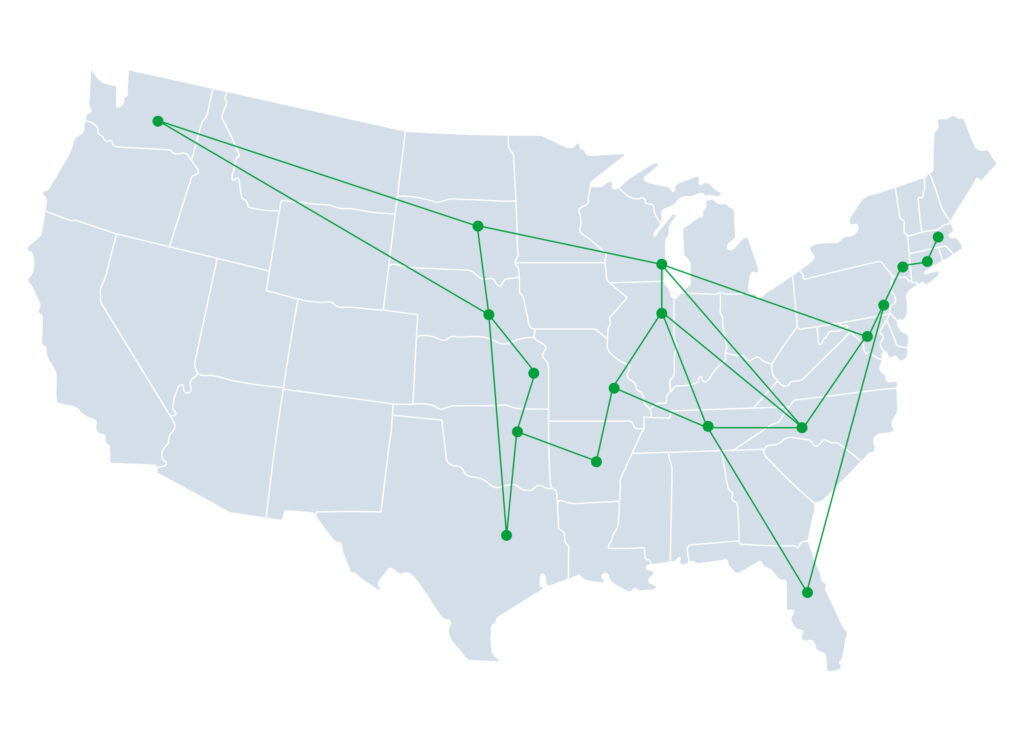
Whether you’re looking to withstand natural disasters or improve connectivity for your end users, data center geo-diversity can give you a competitive edge and bolster your business continuity efforts. The value of data center geo-diversity stems from what businesses can’t afford to do without – low latency connections, failover sites, and reliable access to data, to name a few. We’ll talk about what data center geo-diversity is, its benefits, and what businesses should consider when deciding on a provider.
What is Data Center Geo-Diversity?
Data center geo-diversity is the process of distributing applications and data across geographically distinct regions, it improves the availability and resilience of an organization’s workloads. Spreading out data and applications and adding redundancies with geographically diverse data centers could be important in an organization’s disaster recovery and business continuity plan. When using a single data center or several data centers in the same geographic area, businesses can run the risk of outages due to single points of failure.

Does Data Center Geo-Diversity Matter?
How much data center geo-diversity matters really depends on the location of your main data center, the risks inherent to that geographical area, and how dependent you are on constant uptime and data availability.
Some businesses can survive brief outages and their operations won’t be affected greatly if their systems are down for an hour or even a day. Other companies, especially ones with many users or relying on up-to-the-minute access to data, could lose a lot of revenue, productivity, or trust if they experience brief outages of a few minutes.
If your main data center is in a geographic area prone to extreme weather events such as floods, fires, or earthquakes, and you need to keep downtime as minimal as possible, data center geo-diversity will matter greatly.
Benefits of Data Center Geo-Diversity
When incorporated into your data center location strategy, geo-diversity can offer a lot of benefits, including lower latency, improved disaster recovery, growth and scaling capabilities, and more.

Minimize Latency
Latency is a measure of the time it takes for application data to reach users, and vice versa. By having workloads distributed in different geographic areas, you can improve access to users by processing data closer to where they are.
Facilitate Disaster Recovery
A geographically diverse data center can also serve as a good location for failover when a disaster occurs. When set up ahead of time, the secondary site can be up and running in moments, allowing for seamless access to your systems. The distance between data centers should be far enough away that they wouldn’t be on the same power grid or wouldn’t fall victim to the same natural disasters.
Support Growth and Scaling
Not only does having your workloads in more than one data center lower latency, but it can also support the further growth and scaling of your business. Data center geo-diversity can be a great compliment to edge computing – moving your computing to the “edge” of your network, closer to your end users. You can choose to scale up or down resources in different locations based on user counts and continue to scale your business in several data centers, instead of having everything in one centralized data center that you run.
Data Center Geo-Diversity Non-Disaster Variables
- Security & Compliance may also be a reason to adopt data center geo-diversity. For example, some financial institutions are required to store data in specific jurisdictions, making it necessary to have storage set up in multiple data centers. However, there is no shortage in cybercrime in the world today. Experts estimate that cybercrimes will cost businesses $8 trillion in 2023 alone, according to a report by Cybercrime Magazine. Utilizing geographically diverse data centers and the data center expertise that come along with them will aid in strengthening security and compliance and reduce the risk of costly security incidents.
- Cost is another variable. The size and complexity of your IT infrastructure will dictate how much it will cost to move or duplicate some of your systems to other data centers. The amount of redundancy you’re looking for will also impact the cost of the project.
When You Should Think About Data Center Geo-Diversity
This may be an obvious tip, but the best time to think about data center geo-diversity is before any disasters happen. If you have critical data that needs to be available at all times, you are concerned about natural disasters happening around your current data center, or you’re looking to improve the user experience for geographically dispersed users, data center geo-diversity can be a good move.
However, you’ll also want to think about how this change will fit into your overall IT budget, and what help you’ll need to pull off adding more data center locations if your current data center facility isn’t interconnected or doesn’t offer these services.
How to Choose a Geo-Diversified Data Center Provider
Businesses looking for data center geo-diversity should work with data center providers that offer interconnected facilities that are distributed in areas ideally less prone to natural disasters. These centers should have a proven track record of solid uptime, carry the compliance for regulations important to your business, and have a support team ready to help if a disaster arises. You’ll also want to consider whether you want to bring your equipment to a colocation data center or operate on a pay-as-you-go basis with a public cloud provider.
TierPoint has 40 world-class, interconnected data centers across the country, allowing for geo-diversity and low-latency connections.

